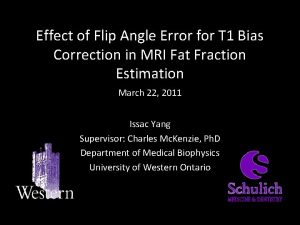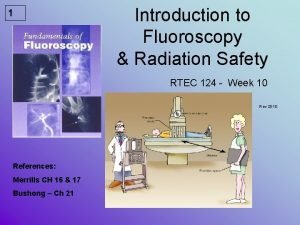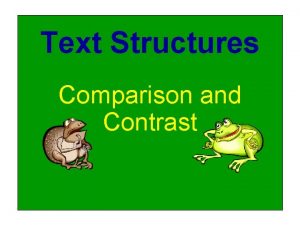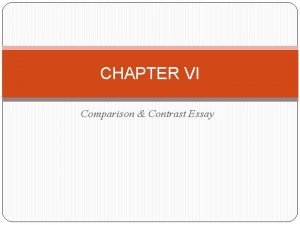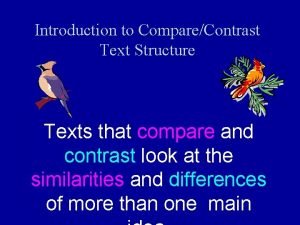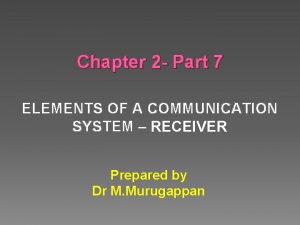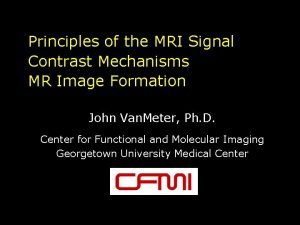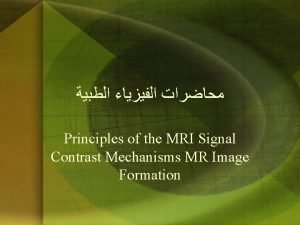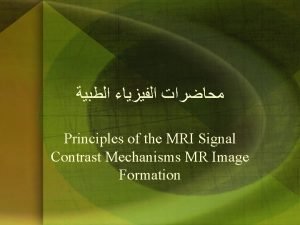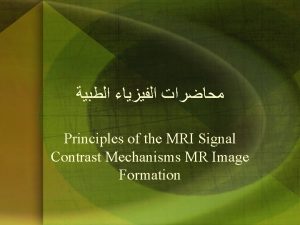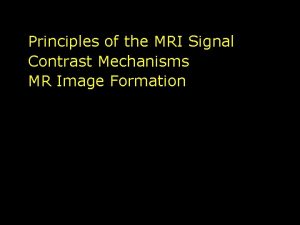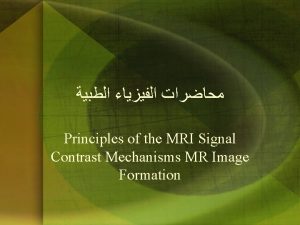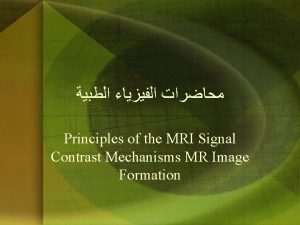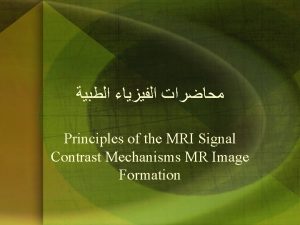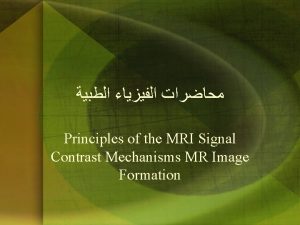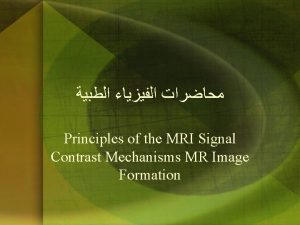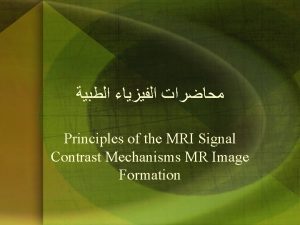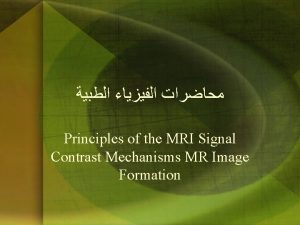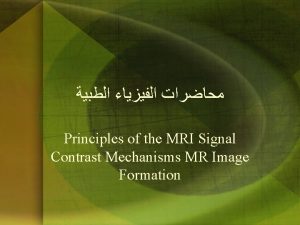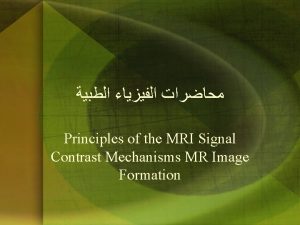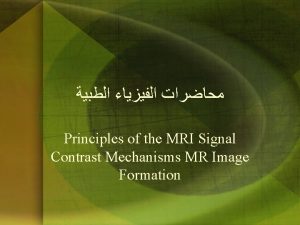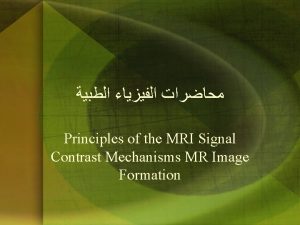Principles of the MRI Signal Contrast Mechanisms MR



















- Slides: 19

ﻣﺤﺎﺿﺮﺍﺕ ﺍﻟﻔﻴﺰﻳﺎﺀ ﺍﻟﻄﺒﻴﺔ Principles of the MRI Signal Contrast Mechanisms MR Image Formation

Contrast Principles of the MRI Signal MR Image Formation Mechanisms ﺍﻟﻤﺤﺎﺿﺮﺓ ﺍﻟﺮﺍﺑﻌﺔ ﺳﻌﻴﺪ ﺳﻠﻤﺎﻥ ﻛﻤﻮﻥ. ﺍﻋﺪﺍﺩ ﺩ ﻛﻠﻴﺔ ﻣﺪﻳﻨﺔ ﺍﻟﻌﻠﻢ ﺍﻟﺠﺎﻣﻌﺔ ﻗﺴﻢ ﺍﻟﻔﻴﺰﻳﺎﺀ ﺍﻟﻄﺒﻴﺔ– ﺍﻟﻤﺮﺣﻠﺔ ﺍﻟﺮﺍﺑﻌﺔ John Van. Meter, Ph. D. Center for Functional and Molecular Imaging Georgetown University Medical Center

Different tissues have different relaxation times. These relaxation time differences can be used to generate image contrast. • T 1 - Gray/White matter • T 2 - Tissue/CSF • T 2* - Susceptibility (functional MRI)

T 1 and T 2 relaxation

SUMMARY OF NMR SIGNAL In brief, we apply an initial magnetic field, B 0 and the protons align with the field while processing at a frequency proportional to the magnetic field strength. We then send RF pulse in the transverse plane (like pinging a wine glass) and the protons align and process accordingly. Thereafter, protons relax in different two ways via emitting RF pulses. This allows us to recognize environmental differences of protons in a given tissue sample.

The MRI Measurement (Sans Spatial Localization) RF time Bo z z Mo y x Voltage (Signal) z 90° y Mo x Mo ty x V(t) time

Main Tissue Contrast Controls • Echo Time (TE) – time after 90 o RF pulse until readout. Determines how much transverse relaxation will occur before reading one row of the image. • Repetition Time (TR) – time between successive 90 o RF pulses. Determines how much longitudinal relaxation will occur before constructing the next row of the image.

Tissue Contrast I n te n s i ty Every tissue has a different affect on longitudinal (T 1) and transverse (T 2) relaxation. Time T 1 Curve T 2 Curve

Contrast in MRI: T 1 -Weighting 1. 0 Signal 0. 8 white matter T 1 = 600 gray matter T 1 = 1000 0. 6 CSF T 1 = 3000 0. 4 0. 2 0. 0 0 1000 2000 TR (milliseconds) 3000

Optimizing TR Value for T 1 Contrast

Effect of Varying TR

T 1 -Weighting • CSF dark • WM bright • GM gray

Contrast in MRI: T 2 -Weighting 10 50 TE (milliseconds)

Optimizing TE Value for T 2 Contrast

Effect of Varying TE

T 2 -Weighting • CSF (fluid) bright • GM gray • WM dark

Contrast in MRI: Proton Density • Tissue with most protons has highest signal and is thus brightest in the image • Proton Density Weighted aka PDW

Summarizing Contrast • Two main “knobs”: – TR controls T 1 weighting – TE controls T 2 weighting • Longitudinal relaxation determines T 1 contrast • Transverse relaxation determines T 2 contrast

But Wait • How do you set TE to generate a T 1 weighted image? • How do you set TR to generate a T 2 weighted image? • How do you set TR & TE to generate a proton density weighted image?
 Fat signal mri
Fat signal mri Double contrast vs single contrast
Double contrast vs single contrast What does compare and contrast means
What does compare and contrast means Difference between brownie and cake
Difference between brownie and cake Example of cause and effect signal words
Example of cause and effect signal words Signal words for compare and contrast
Signal words for compare and contrast Notice and note nonfiction
Notice and note nonfiction Venn diagram of cardinal and cedar waxwing
Venn diagram of cardinal and cedar waxwing Baseband signal and bandpass signal
Baseband signal and bandpass signal Baseband signal and bandpass signal
Baseband signal and bandpass signal Digital signal as a composite analog signal
Digital signal as a composite analog signal Even odd signals
Even odd signals Design principles contrast
Design principles contrast Proximity and harmony
Proximity and harmony Basic principles of signal reproduction
Basic principles of signal reproduction Hát kết hợp bộ gõ cơ thể
Hát kết hợp bộ gõ cơ thể Frameset trong html5
Frameset trong html5 Bổ thể
Bổ thể Tỉ lệ cơ thể trẻ em
Tỉ lệ cơ thể trẻ em Chó sói
Chó sói
